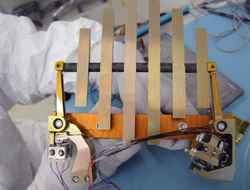
Posted to News on 13th Feb 2020, 10:38
maxon is flying to the Sun
Solar Orbiter has started its mission to provide scientists with new data about the Sun. Swiss research and industry have played a significant role in the construction of the space probe - with drives from Obwalden among the contributions.

The European Space Agency (ESA) wants to study the Sun up close. On February 10th the agency launched the Solar Orbiter space probe, which is equipped with ten measuring instruments. Scientists hope that the mission, which will last several years, will provide them with new insights into phenomena such as the solar wind, as well as the complex dynamics that are responsible for solar eruptions. Solar Orbiter will fly to within 45 million kilometres of the Sun - closer than Mercury, its nearest planet. At this distance, the side of the probe facing the Sun will be exposed to intense heat: more than 500 degrees Celsius. A heat shield will protect the valuable instruments on board the probe, equipped with shutters to provide a view of the Sun only when measurements are being taken.
The same applies to the spectrometer-telescope for imaging X-rays (STIX), whose purpose is to study solar eruptions more closely, possibly enabling large-scale eruptions to be predicted in future. STIX was developed at the University of Applied Sciences and Arts Northwestern Switzerland (FHNW) in collaboration with several industrial partners from Switzerland, including Almatech. Swiss drives made by maxon are among the components used in the X-ray telescope. Two specially modified DC motors with diameters of 13mm move an aluminium attenuator, which slides in front of STIX's 30 detectors as required. The micro drives are wired in parallel and can be used together or individually. This ensures that they will run smoothly for the entire five years planned for the mission. The design is based on micromotors that will soon be used in ESA's ExoMars Rover. Key factors when selecting the drives were their low weight, energy efficiency, and resistance to vibration.
Solar Orbiter is one of ESA's flagship projects and has cost more than a billion Swiss francs. After its launch, the probe will journey for almost two years before it can start taking measurements. The mission is scheduled to end in 2025.
With the Solar Orbiter successfully launched, preparations are underway for the next two major Mars projects, which are scheduled to start in the summer of 2020: NASA's Mars2020 Rover and ESA's ExoMars Rover. The aim of both missions is to provide new information about the Red Planet, answering questions such as whether there has ever been life on Mars. Mars2020 also carries a small helicopter to deliver a proof of concept that flights are possible on Mars despite the very thin atmosphere.
maxon drives are used for mission-critical tasks in both projects, including wheel drives, handling soil samples, and steering the Mars helicopter.
Learn more about maxon products at www.maxonmotor.co.uk.
Want the latest machine building news straight to your inbox? Become a MachineBuilding member for free today >>

















